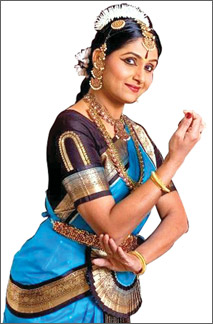Dance in modern and ancient works
Subashini Pathmanathan
The ancient world regarded dance and drama as a single field of
study. They called them by generic name Koothu. So too in the
inscriptions, dance and drama were referred to as koothus.
|

Baratha Sangeerthana deals with different forms of folk dance
|
Although dance and drama were two different fields of study, they
continued to develop together. It was not till the 17th Century that
dance and drama started developing as two distinct and different forms.
Most ancient works in Tamil on dance and drama perished due to
natural and man-made causes. Perhaps these works were not adequately
preserved. Foreign invasions and religious bigotry were some of the
other causes. Some Olas were thrown into sea or rivers, some were burnt,
and some were naturally destroyed.
Eventually, some scholars searched and discovered these works. Some
works were published with corrections.
In the time of Adiyarku Nallar of the 13th Century AD, who wrote the
commentary on the Tamil classic Silapathikaram, stated that during his
time, many works had perished, and some other works he named were not
available even in his time. Some works he mentioned to exist are no
longer available.
Today we regard Bharatham as a work on dance. However in the olden
days Bharatham was regarded as a work on drama. Adiyarku Nallar in his
commentary referred to many ancient works on dance and drama. So too, a
work of Athivayelaar’s, Paratha Senathi Pathiyam is different from the
version which exists today.
A work called Chandam describes different koothu forms mentioned in
Silapathykaram. Among other ancient works, Baratha Sasthiram and
Vethantha Sasthiram are no longer available. Nevertheless Natya Sasthram,
which is believed to have been written by Bharatha Muni, is still
available.
Even though most of these works have perished, we get an inkling of
what they contained through the references and quotations made in
subsequent works.
|

A group of dancers |
The ancient Tamil classic Manimekali states that dancers were
encouraged to learn theory related to dance. In the modern works on
dance some are based on Nirtham, some are based on Nirutham and some are
combination of Nirtham and Nirthiyam.
A few of existing valuable works on dance are Silapathykaram, Natya
Sasthram, Abinaya Darpanam, Mahabaratha Chdamani, Sangeetha Muthaavali.
Sangeetha Saaraaamirtham, Natya Nannool and Bharatha Kalai Kodpaadu.
Nevertheless, there are differences between the basic facts contained in
different works.
For instance Bharatha Senaathipathiyam states that dance could be
divided into five different categories, but generally dance is divided
into three main categories: Nirutham, Niruthiyam and Natyam.
In 1710 AD Thulaja Maha Raja wrote a thesis on dance called Sangeetha
Saaraamertham dealing with different Adavus.
In 1886, Narayana Iyengar compiled two Tamil dance books Abinaya
Navaneetham and Abinaya Sarasampudam. Similarly Devenderan wrote
Sangeetha Mukthaavali, dealing with different items of dance.
Baratha Sangeerthana deals with different forms of folk dance. Even
works on music refer to dance. In the 13th Century Saaranga Devar wrote
a thesis on music called Sangeetha Ratna Kaaram, in which one chapter is
devoted to classical dance.
In the modern world, numerous books, magazines, pamphlets written by
various scholars, and artistes, have been periodically published. Some
by foreign scholars, in foreign languages.
Some of the popular works in English are Dr. Anne Marine Gaston’s
‘Siva in Dance Myth and Iconography’, ‘Mirror of Gesture’ (English
translation of Abinaya Darpana of Nandikesvara by Dr Ananda Coomaraswamy,
and also ‘Dance Of Siva’ by Dr Ananda Coomaraswamy) ‘Bharatha Natyam the
Tamil Heritage’, by Lakshmi Viswanathan, and ‘The Other Mind’, by Zoete,
Beryl De.
|



